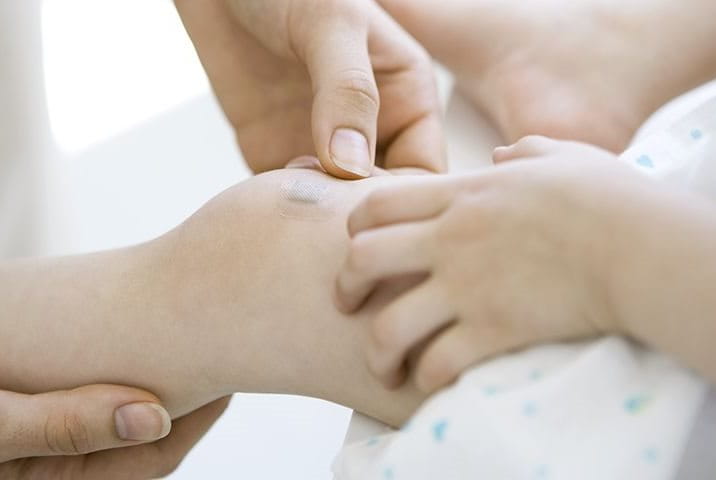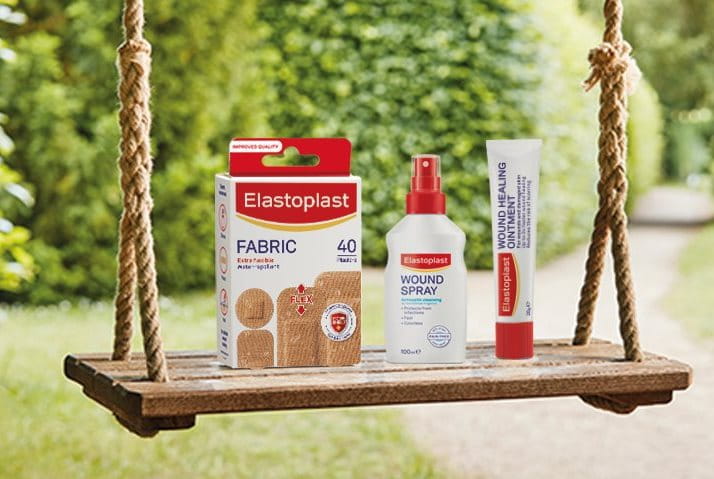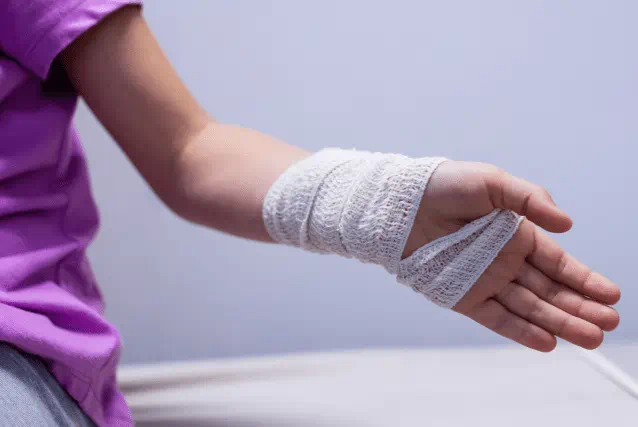Experiencing an itch around your wound? An itchy wound can be more than just a minor annoyance; it can indicate various stages of healing or even underlying issues that require attention. It's actually a positive sign because an itchy wound means that your wound has started to dry and is almost healed.
Understanding the causes of itchiness in a wound and knowing how to manage it effectively, are important for ensuring proper healing and comfort. Read on to find out more about itchy wounds.
Why do wounds itch?
Wounds can itch for several reasons, including the body’s natural healing process, nerve irritation, or the release of histamines—chemicals released by the immune system that trigger allergic reactions. To understand better the causes of itching, it’s important to learn how a wound – including one that has been stitched – undergoes the healing process.
Inflammation or Histamine releases
When a wound heals, white blood cells like neutrophils and macrophages clean the area and initiate tissue repair by releasing chemicals such as histamine that cause inflammation. Histamine plays multiple roles in inflammation, including:
- Increasing blood flow
- Enhancing vessel permeability to immune cells and proteins
- Signalling other immune cells to respond to injury or infection
- Interacting with skin nerve endings, causing itching by stimulating signals interpreted by the brain as irritation
This process is part of the body's defence mechanism and inflammatory response to injury, irritation, or infection.
Nerve healing
When your skin is injured, the nerves around the area can also become irritated, inflamed, or damaged. In most cases, nerve damage occurs with injuries such as deep wounds, burns, infections, lacerations, and punctures. If the wound has affected the nerves, nerve healing or regeneration can also result in itching.
Proliferation and repair
During the proliferation phase, new tissue forms to replace the damaged tissue. This process involves the growth of new skin cells, blood vessels, and connective tissue. As the new skin cells form and the wound contracts, it can lead to itching. The stretching and movement of the new tissue can irritate the nerve endings, causing an itchy sensation.
Scabbing and dryness
As the wound heals and a scab forms, the area may become dry and tight. This dryness can aggravate the skin and nerve endings, leading to itching.
How do you stop a wound from itching?
It's totally normal to have itchy wounds; lots of people go through it. But sometimes, that itchiness can be really uncomfortable. To ease the itching from your wound, here are a few things you can try:
1. Keep the wound clean and dry
Regularly cleaning and drying the wound is important to prevent infection, that may contribute to itching, and speed up the healing process. Clean the wound gently with mild soap, water, and Elastoplast Wound Spray, pat it dry with a clean towel (do not rub it), and use an appropriate wound dressing. To make sure you clean thewound properly, you can use this step-by-step guide to clean wounds.
2. Apply a wound healing ointment
Applying a wound-healing ointment to an itchy wound can help reduce discomfort and support proper healing. Elastoplast Wound Healing Ointment contains ingredients that soothe the skin, reduce inflammation, and provide a barrier to protect the wound from further irritation. The ointment is also designed to support and speed up the natural healing of minor superficial wounds such as cuts, abrasions, scratches, and even first and smaller second-degree burns. You can use the ointment at any stage of the healing process on superficial open wounds and damaged skin. The Elastoplast Wound Healing Ointment is very skin-friendly, clinically proven to promote faster wound healing, and reduce the risk of scarring.
3. Avoid scratching
Although it can be tempting, scratching the wound can delay healing and increase the risk of infection. Try to resist the urge to scratch by keeping the area covered with a bandage, plaster, or wound dressing.
Elastoplast Water Resistant Plaster is suitable for covering and protecting all types of minor wounds, with strong adhesion ensuring that the plaster stays in place so you won’t be tempted to scratch the wound.
4. Apply cold compresses
Cold compresses or ice packs can help numb the area and reduce itching. Wrap the cold pack in a soft cloth or towel and apply it to the itchy area for 10 to 15 minutes at a time.
5. Moisturise
Dry skin can worsen itching, so moisturising the skin can help reduce the itchiness. You can use a gentle moisturiser or lotion on the surrounding skin, but avoid direct application to the wound itself. Also, use fragrance-free lotions or ointments on the skin around the wound to prevent dryness and itching. Applying a thin layer of petroleum jelly can also help keep the wound moist and reduce itching. Find out more about moist wound healing.
6. Topical treatments
Creams with hydrocortisone or calamine can relieve itching. Over-the-counter antihistamine creams can help with itching from allergic reactions, and mild corticosteroid creams can reduce inflammation and itching. You can also use calamine lotion to soothe and cool the skin. Follow product label instructions and avoid applying these creams directly to open wounds unless advised by a healthcare professional.
7. Consult a healthcare professional
Sometimes, despite our best efforts, home remedies may not be sufficient to reduce itching or address potential complications.
A healthcare professional can assess the wound and recommend appropriate treatment options.
Why you shouldn’t scratch itchy wounds?
Scratching itchy wounds is strongly discouraged because it can be harmful for a few reasons: it increases the risk of infection, delays the healing process, increases scarring, and intensifies the pain.
Scratching introduces bacteria from your nails and fingers into the wound, increasing the risk of infection. An infected wound will show several signs and symptoms including increased pain, redness, swelling, warmth, pus, foul odour, or in some cases, infection can lead to fever. If you notice any of these symptoms, seek medical attention quickly. Infected wounds can worsen without proper treatment and may require antibiotics or other interventions to heal properly.
Delayed healing
Scratching an itchy wound can delay healing by causing further damage, disrupting the natural healing process and extending the time it takes for the wound to heal completely. Scratching can also delay healing by increasing inflammation, raising the risk of infection due to bacterial introduction, and extending exposure to irritants. Resisting the urge to scratch and employing gentle methods to alleviate itchiness can promote proper healing and reduce the risk of complications.
Increased scarring
Scratching wounds can increase scarring due to the additional tissue damage it causes, the heightened inflammation around the wound site, the delay it imposes on the healing process by preventing scab formation and exposing the wound to potential infection, and the repeated trauma inflicted on the area.
Elastoplast Wound Healing Ointment is clinically proven to aid and speed up natural healing while also reducing the risk of scarring. To ensure proper healing, apply the ointment regularly until your wound is completely healed.
Pain intensification
Though scratching can temporarily relieve itching, it can also cause pain and discomfort, particularly if the wound is tender. Scratching further irritates the wound and surrounding skin, increasing sensitivity and discomfort. It also disrupts the healing process by causing additional trauma, leading to heightened pain. Moreover, it can introduce bacteria from nails and fingers into the wound, increasing the risk of infection and inflammation.
How long does a wound take to heal?
The time it takes for a wound to heal highly depends on the severity of the wound. Read more below to understand the wound healing time based on the severity of the wound.
Minor cuts
Minor injuries, such as superficial scrapes and cuts, typically heal within a week. These wounds may close and form a scab within a few days, and the scab usually falls off after about a week. Read more about how to take care of minor cuts and grazes.
Moderate or deep cuts that require stitches typically heal within one to three weeks, but it can take months for scarring to fully disappear.
Surgical wounds
Surgical wounds typically take six to eight weeks to heal, but this can vary depending on the type of surgery and the patient’s health.
Chronic wounds
Chronic wounds, such as pressure ulcers, diabetic foot ulcers, and other wounds that struggle to heal properly, can take much longer, often several months or more, and may require ongoing medical care.
Read this article to learn more about three simple steps to heal cuts safely and easily.
FAQ about itchy wound (3)
-
How to stop itching a wound?
If your wound itches, it's actually a positive sign that means your wound has also started to heal. To manage the itching, make sure that you follow these steps below:
- Keep the wound clean and dry.
- Avoid scratching because it will delay healing and increase the risk of infection.
- Apply cold compression for 10 to 15 minutes at a time.
- Put some fragrance-free lotions or petroleum jelly to keep your skin moist.
- Apply some over-the-counter antihistamine creams, mild corticosteroid cream, and calamine lotion to reduce inflammation and itching and soothe and cool the skin.
- Seek medical advice if the itching persists or worsens, or if you notice signs of infection such as redness, swelling, or discharge from the wound.
-
Is it normal for a wound to itch?
Yes, it's completely normal for a wound to itch as it heals. Itching is a natural part of the healing process and can occur as new tissue forms and nerves become more active. However, excessive scratching can disrupt healing and increase infection risk. Try using gentle methods like cold compresses or moisturizers to relieve itching. If itching persists or worsens, or if you notice other concerning symptoms, seek medical advice.
-
How to tell if a wound is healing or infected
Determining whether a wound is healing or infected involves observing certain signs. Here are indicators of healing:
- Reduced Pain
- Decreased Redness
- Less Swelling
- Formation of Granulation Tissue
- Closing of Wound
Signs of infection include: - Increased Pain
- Persistent Redness
- Swelling Worsening
- Pus or Discharge
- Fever
If you suspect you have an infection, it's important to seek medical attention promptly to prevent complications. Learn more about recognising signs of an infected cut or wound.





